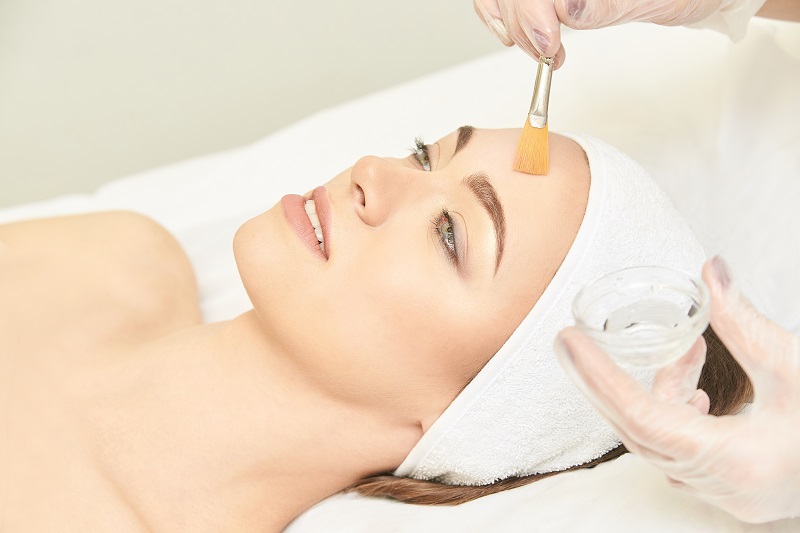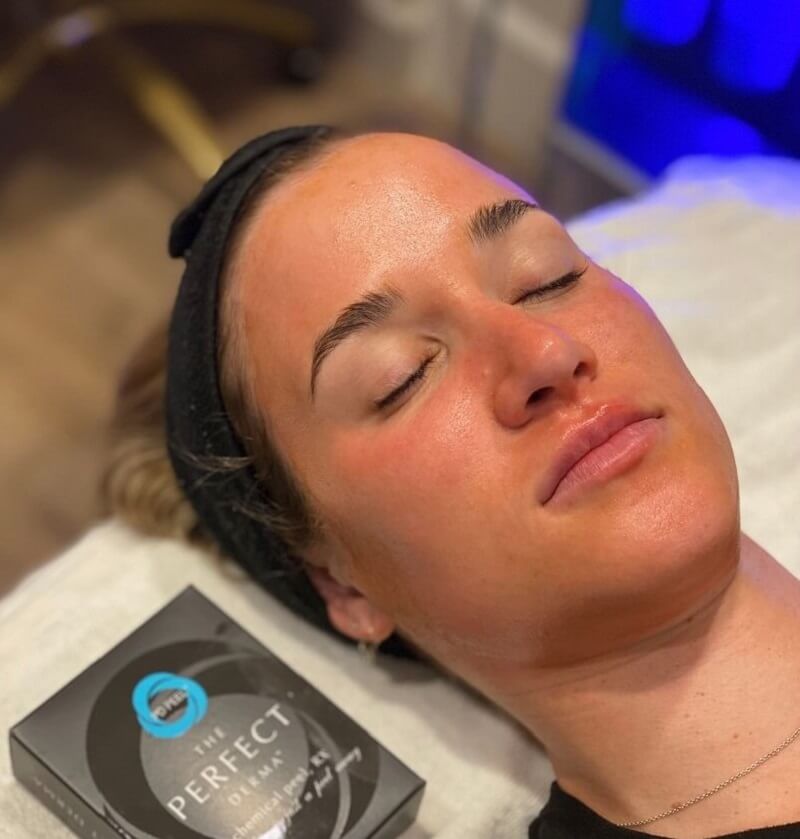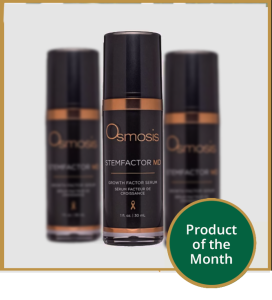Our skin is our first line of defense against harmful environmental factors, but it’s not invincible. The buildup of dirt, dead cells, and pollutants in the skin, combined with the harmful effects of sun exposure, cause the first signs of aging skin start to appear as early as our 20s.
Fortunately, there is a solution. This article explains how chemical peels work to transform sun-damaged skin and leave you with a rejuvenated complexion.

What Is a Chemical Peel?
A chemical peel is a skin resurfacing treatment for the face, neck, and hands. The treatment involves the application of a chemical solution to the treated area, causing controlled damage to the skin. The damaged skin gradually peels off and is replaced by new, smoother, brighter skin.
Note: Besides common treatment areas, chemical peels are sometimes used to treat acne and acne scars on the back. Find out how a back chemical peel works and who should undergo this treatment.
Types of Chemical Peels
Chemical peel types differ based on the chemical solution used, how deeply it penetrates the skin, and what conditions it treats. Your chosen medical provider will help you choose a chemical peel for your specific skin issue and goals.
1. Light Chemical Peel
Light chemical peels typically use gentle exfoliating agents like alpha and beta hydroxy acids that penetrate the skin’s top layer. They treat:
- Skin discoloration
- Uneven skin texture
- Dryness
- Fine wrinkles
- Acne
For full results with this type of chemical peel, patients usually need a series of treatments. There is little to no downtime after light peels.
2. Medium Chemical Peel
Medium chemical peels use trichloroacetic acid, glycolic acid, and Jessner’s solution that penetrate top and middle skin layers. They are effective for:
- Dead skin cell removal
- Fine lines and wrinkles
- Age spots
- Skin discoloration
- Acne scars
Patients need downtime after medium chemical peels and usually recover within one week.
Note: Find out what is the best chemical peel for acne scars.
3. Deep Chemical Peel
Deep chemical peels use trichloroacetic or carbolic acid (phenol) that deeply penetrates the middle skin layers. They are effective for:
- Dead skin cell removal
- Deeper wrinkles
- Age spots
- Skin discoloration
- Scars
- Precancerous growths (actinic keratosis)
The patient is given a sedative, local anesthetic, or in rare cases, general anesthesia. Deep chemical peels provide the most dramatic results with only one treatment, but they also require the longest recovery and two months of pre-treatment preparation.
Note: If you want to explore other options for dark spots as well, check out our article and find out how to remove age spots and what might work best for your skin type.
Who Is a Good Candidate for Chemical Peel?
The best candidates for chemical peels are people with fair skin because people with darker pigmentation often experience a condition called post-inflammatory hyperpigmentation. That’s when the newly grown skin differs in color from the rest of the patient’s skin.
Chemical peels are best used in people who wish to treat aging signs caused by too much sun exposure.
What Conditions Does a Chemical Peel Treat?
Chemical solutions used in chemical peels stimulate the body’s natural healing processes to grow new, rejuvenated skin and treat numerous skin issues. Chemical peels eliminate or improve:
- Uneven skin texture
- Skin discoloration
- Dull complexion
- Dry skin
- Age spots
- Fine wrinkles
- Thinning skin
- Some types of acne
- Acne scarring
- Actinic keratosis
How to Prepare for a Chemical Peel Treatment?
Preparing for a chemical peel is an important step that determines the treatment’s safety and effectiveness. The preparation steps and duration are individual and depend on the patient’s skin issue and type of chemical peel.
Your medical provider will instruct you on what to do for the best results. Preparation may involve some of the following:
- Taking antiviral medication for one week before the treatment.
- Avoiding retinoid creams for 3-7 days prior to the treatment.
- Using hydroquinone for several days before the treatment.
- Avoiding the sun, tanning beds, and saunas for several weeks.
- Avoiding certain cosmetic treatments (hair removal, facial masks, laser resurfacing, etc.).
What to Expect During a Chemical Peel Treatment?

A chemical peel treatment starts with a consultation with your chosen medical provider, who determines the optimal type of peel depending on your skin issue, desired goals, and budget.
The medical provider cleans the skin and dabs or paints a chemical solution onto the treatment area with gauze, a cotton ball, a brush, or a special applicator.
The solution is left on the skin for several minutes. The medical provider then washes or neutralizes the chemicals with water, a saline compress, or a neutralizing solution.
The total treatment time is between 15 and 60 minutes.
Are Chemical Peels Painful?
Chemical peels are not painful because providers either use gentle ingredients or use numbing agents. The patients usually feel only mild to moderate stinging and burning.
The treatment’s intensity depends on the chemical peel type. Light peels use gentle chemical solutions and don’t require any sedation or anesthesia.
Some medium peel patients need a numbing cream, depending on their pain threshold.
Deep chemical peels require sedation and local or general anesthesia before the treatment. Doctors also prescribe painkillers after the treatment.
Chemical Peel Results
Chemical peels improve the skin’s tone and texture. After the top skin layer peels off, the newly grown skin is brighter and smoother. The treatment reduces the appearance of wrinkles around the mouth and eyes, scars, age spots, and other skin imperfections.
How Long Does the Skin Peel After a Chemical Peel Treatment?
Light peels may cause slight skin flaking for two or three days, but patients often don’t experience any peeling. Medium peel patients typically peel for up to one week. Deep peels cause more dramatic side effects, including peeling that lasts up to two weeks.
How Long Do the Effects of a Chemical Peel Last?
Light chemical peels provide subtle results that last for about one month and require repeated treatments. Medium chemical peels leave more visible results for about six months after a series of treatments. Deep chemical peels involve one treatment and provide dramatic effects that may last for years.
Chemical Peel Aftercare
Aftercare tips provided by your medical provider will help you speed up the recovery after a chemical peel. Different chemical peel types require different aftercare regimes. The following general tips apply to all chemical peels:
- Avoid the sun.
- Apply cold compresses.
- Take pain relief medication (e.g., ibuprofen).
- Use a broad-spectrum sunscreen with SPF 30+.
- Apply ointment prescribed by your medical provider.
- Avoid picking, rubbing, and scratching your skin.
Note: For more tips, check out our complete guide to chemical peel aftercare.
Chemical Peel Side Effects
Depending on the type of chemical peel, you may experience the following side effects:
- Redness
- Swelling
- Stinging
- Skin flaking
- Skin irritation
- Peeling
- Blisters and crusting
- Dryness
- Discomfort
Light chemical peels cause minimal side effects, while redness from deep chemical peels may last for three months.
More severe risks of chemical peel treatments include:
- Scarring
- Infection
- Reactivation of cold sores
- Hyperpigmentation
- Heart, kidney, or liver damage from deep chemical peels
Who Should Not Get a Chemical Peel?
Some health conditions increase the chance of unwanted results after chemical peels. They include:
- Pregnancy
- Taking oral birth control
- Taking certain acne medication
- A history of scarring
- A history of severe outbreaks of cold sores
- A history of skin discoloration
Medical providers caution these patients against chemical peels or recommend a particular pre-treatment regimen to reduce the risk of skin damage.
How Much Does a Chemical Peel Cost?
The American Society of Plastic Surgeons estimates the average chemical peel costs $519.
Vibrant Skin Bar skin experts offer light and medium chemical peels. Light peels cost $99 per session, and medium peels cost $125 per session. Deep peels may cost up to a few thousand dollars because they require anesthesia and carry more risk.
Conclusion
Chemical peels rank highly among cosmetic treatments. Patients love them, especially the less invasive light and medium peels, because they provide impressive results with low risk and without needles.
To enjoy youthful, glowing skin and a smooth complexion once again, consider having a chemical peel. However, make sure you choose a licensed medical professional to ensure you get the desired results.
If you want to find out how effective chemical peels are compared to other cosmetic treatments, read our articles chemical peel vs. laser and microneedling vs. chemical peel, and choose the treatment that best suits your needs.




